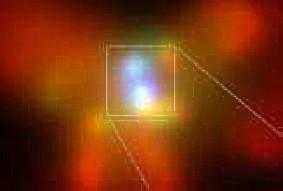
Satellites solve mystery of deep-space blasts
Dense neutron stars collide, producing gamma-ray bursters
Keay Davidson
Chronicle Science
The San Francisco Chronicle
10-6-05 Writer
NASA announced the resolution of a cosmic mystery that dates back to the 1960s: the cause of incredibly powerful explosions in deep space -- blasts so strong that a single one emits as much light as 100,000 trillion suns.Dense neutron stars collide, producing gamma-ray bursters
Keay Davidson
Chronicle Science
The San Francisco Chronicle
10-6-05 Writer
One of the two main types of blasts happens when two tiny, hyper-dense stars known as neutron stars -- each one roughly the size of San Francisco -- ram into each other at a speed of many tens of thousands of miles per second. During the collision, they explosively squirt a narrow, fire hose-like gusher of deadly gamma radiation trillions of miles into space, scientists said at a National Aeronautics and Space Administration press conference in Washington on Wednesday.
The blasts, known as gamma-ray bursters, typically happen billions of light years from Earth, and that's a darn good thing: If one of the blasts occurred somewhere inside the star-packed Milky Way galaxy, the gusher of gamma radiation might rip off Earth's atmospheric ozone layer, exposing the planet to solar ultraviolet radiation and killing us all.
Indeed, it's possible that gamma-ray bursters have popped off inside our galaxy during Earth's 5 billion-year history. Some might even have helped trigger the extinction of terrestrial life forms long ago, a few scientists have speculated over the years.
However, the chance that such a cosmic Katrina would occur near Earth at the present time is extremely low, so "don't buy gamma ray burst insurance," joked cosmologist Edward "Rocky" Kolb of the Fermi National Accelerator Laboratory, near Chicago, during Wednesday's press conference.
Gamma ray bursters were accidentally discovered in the late 1960s by U.S. military satellites, which had been launched to detect radiation from secret Soviet nuclear weapons tests.
Later, astronomers realized there are two basic types of bursters: "long bursts" and "short bursts." Long bursts last more than two seconds, and short bursts less than two seconds.
Initially, astronomers assumed that all types of gamma-ray bursters were the same kind of phenomenon. About a decade ago, astronomers hit on what appeared to be a satisfying explanation for long bursts: that they're caused by radiation gushed during the collapse of a massive star.
Stellar collapse, they concluded back then, occurs for the same reason that a hot-air balloon deflates when its heater runs out of fuel. Many stars are "inflated" by heat and pressure generated from nuclear fusion of the nuclei of hydrogen atoms inside their super-hot cores. When the star runs out of hydrogen, it begins burning the nuclei of atoms heavier than hydrogen, and eventually it can't burn any nuclei fast enough to remain inflated. Thus the star collapses.
However, by the 1990s astronomers suspected that the cause of short bursts was fundamentally different from the cause of long bursts.
On Wednesday at the NASA press conference, scientists said that thanks to observations from space satellites, they had found close-to-smoking-gun evidence that a short burst involves the collision of either two neutron stars or of a neutron star and a black hole.
A black hole is a collapsed star with such immense mass that its gravity prevents anything from escaping, including light -- hence the moniker "black."
Wednesday's announcement is based on observations of gamma-ray bursts earlier this year by satellites including the High Energy Transient Explorer, the Swift Gamma-Ray Burst Explorer, the Chandra X-ray Observatory and the Hubble Space Telescope, as well as by observations from ground-based telescopes.
Further details on the scientists' findings are scheduled to appear in several articles published in today's issue of the journal Nature. The articles' authors include many from California, among them Kevin Hurley, a senior space fellow at UC Berkeley's Space Sciences Laboratory.
Despite Wednesday's announcement, there are still loose ends waiting to be tied up, Hurley and a few other scientists cautioned.
Hurley, for example, suspects there is a third type of gamma-ray bursts -- explosions caused by neutron stars with extremely powerful magnetic fields, known as magnetars.
Also cautious is noted UC Berkeley astrophysicist Alex Filippenko, a veteran researcher on gamma-ray bursters who was not connected with the articles published today. He told The Chronicle that Wednesday's announcement offers "exciting data, and strengthens the conclusion previously made by other groups that short-duration gamma-ray bursts probably come from mergers of binary neutron stars. But additional observations will be needed to make the case even more compelling."
In any case, "now we're 90 percent confident we know what the short bursts are," said astrophysicist Peter Meszaros of Pennsylvania State University. "That's a huge load off our shoulders."
More . . .
Home

No comments :
Post a Comment
Dear Contributor,
Your comments are greatly appreciated, and coveted; however, blatant mis-use of this site's bandwidth will not be tolerated (e.g., SPAM etc).
Additionally, healthy debate is invited; however, ad hominem and or vitriolic attacks will not be published, nor will "anonymous" criticisms. Please keep your arguments "to the issues" and present them with civility and proper decorum. -FW